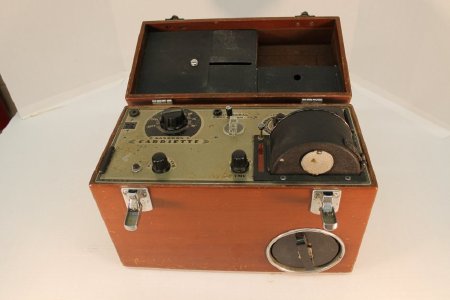Object ID Number:
EH101137
Object Name:
Electrocardiograph Machine
Type:
Phonocardiograph; EKG Machine
Manufacturer:
Sanborn Company – Cambridge, MA
Date of Manufacture:
/ /
Manufactured from:
1940
Manufactured to:
1960
Description / History:
This Sanborn Cardiette Phonocardiograph is a portable EKG machine in a wooden case with metal clasps and leather handle. The patent number is 2,180,160. It dates to the 1940s, but a picture and description of this machine appears in the September 1948 issue of Radio Craft, a magazine about radio electronics. At the time, a regular EKG machine could record the electrical potentials of the heart, but could not record the functioning of the valves at each of the four chambers, allowing blood in and out of the heart. The movements of these valves can be detected by the sounds they make. This phonocardiograph allowed physicians to better hear these sounds when compared to an acoustical stethoscope so that heart murmurs could be diagnosed. This machine has a microphone and audio amplifier so that an accurate and efficient recording of the heart sounds on film can be made. It also makes simultaneous electrocardiograms on the same film. The Sanborn Company converted the table model ECG into the first portable version. It was founded in 1917, acquired by Hewlett–Packard in 1961 and then by Philips Medical Systems in 1999.
This EKG model was one of the earliest used in Lancaster County. It was issued to medical technicians in the U.S. Army who were deployed in Europe during World War II.
This EKG model was one of the earliest used in Lancaster County. It was issued to medical technicians in the U.S. Army who were deployed in Europe during World War II.
Dimensions:
H–11 W–7.25 L–14.5 inches
Additional Information:
Electrocardiograms (EKGs)
An electrocardiogram (also called ECG or EKG) is a noninvasive test that records the electrical activity of the heart. This examination is useful because, with each heartbeat, an electrical signal spreads from the top to the bottom of the heart. As this electrical signal travels, it induces the heart to contract, and to pump blood throughout the body. Since the heart's electrical signals determine the rhythm of the heartbeat, an EKG can be used to show how quickly the heart is beating, whether the heart's rhythm is steady or irregular, and how strongly the electrical signals pass through each part of the heart. Based on these readings, a physician may discover a number of conditions, such as arrhythmias or recent heart attacks, and may also monitor the functioning of implanted pacemakers.
The earliest electrocardiogram was designed in 1901 by William Einthoven, a scientist from the Netherlands. In Einthoven's design, currents from the heart's electrical signals were carried down a silver coated glass conducting wire which was suspended between two electromagnets. The fluctuations of the wire as a result of the changing electrical currents were transcribed onto a photographic plate and produced readouts similar to those given by modern EKGs (although Einthoven's machine weighed 600 pounds, took up two rooms, and needed five people to operate).
EKGs remain one of the most important diagnostic tools today, and in 2011, 82,707 EKGs were performed at Lancaster General Hospital (or affiliated healthcare institutions), which amounts to a staggering 226 per day.
An electrocardiogram (also called ECG or EKG) is a noninvasive test that records the electrical activity of the heart. This examination is useful because, with each heartbeat, an electrical signal spreads from the top to the bottom of the heart. As this electrical signal travels, it induces the heart to contract, and to pump blood throughout the body. Since the heart's electrical signals determine the rhythm of the heartbeat, an EKG can be used to show how quickly the heart is beating, whether the heart's rhythm is steady or irregular, and how strongly the electrical signals pass through each part of the heart. Based on these readings, a physician may discover a number of conditions, such as arrhythmias or recent heart attacks, and may also monitor the functioning of implanted pacemakers.
The earliest electrocardiogram was designed in 1901 by William Einthoven, a scientist from the Netherlands. In Einthoven's design, currents from the heart's electrical signals were carried down a silver coated glass conducting wire which was suspended between two electromagnets. The fluctuations of the wire as a result of the changing electrical currents were transcribed onto a photographic plate and produced readouts similar to those given by modern EKGs (although Einthoven's machine weighed 600 pounds, took up two rooms, and needed five people to operate).
EKGs remain one of the most important diagnostic tools today, and in 2011, 82,707 EKGs were performed at Lancaster General Hospital (or affiliated healthcare institutions), which amounts to a staggering 226 per day.
